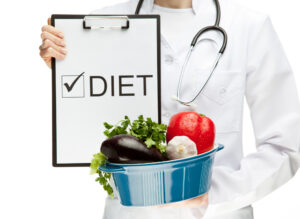What Are The Pros And Cons Of Produce Prescriptions?
Author: Dr. Stephen Chaney
 Can you imagine a world in which doctors asked their patients how many fruits and vegetables they were eating rather than how many drugs they were taking? Can you imagine a world in which doctors advised their patients to try a healthier diet before they put them on drugs?
Can you imagine a world in which doctors asked their patients how many fruits and vegetables they were eating rather than how many drugs they were taking? Can you imagine a world in which doctors advised their patients to try a healthier diet before they put them on drugs?
Unfortunately, that world doesn’t exist currently and is unlikely to exist in the foreseeable future.
But what if there were another approach to encourage healthier eating? And what if it made a meaningful impact on people’s health?
There is such an approach, and it’s called a “produce prescription”.
“What are produce prescriptions?”, you might ask. Simply put, produce prescriptions are government programs that provide lower-income Americans with food insecurity extra income that can only be spent on fresh fruits and vegetables.
And it isn’t a lot of extra income. Previous studies have shown that lower-income Americans only need an extra $63 to $78/month to afford the recommended 3-5 servings of fresh fruits and vegetables a day.
But do produce prescriptions work? Do they significantly improve the diet and health of lower-income Americans who participate in programs offering produce prescriptions?
These are the questions that the authors of the current study (K Hager et al, Circulation: Cardiovascular Quality And Outcomes; 16:e009520, 2023) set out to answer.
How Was The Study Done?
 The authors evaluated the results from 9 pilot produce prescription studies that were administered at 22 sites in 12 states between 2014 and 2020. These pilot studies were generally funded as experimental programs through Medicare and SNAP.
The authors evaluated the results from 9 pilot produce prescription studies that were administered at 22 sites in 12 states between 2014 and 2020. These pilot studies were generally funded as experimental programs through Medicare and SNAP.
The pilot programs enrolled:
- Adults at risk for poor cardiometabolic health (at risk for both heart disease and diabetes). The enrollment criteria included being overweight or obese and having either diabetes or elevated blood pressure.
- Children who were overweight or obese.
- People recruited from health centers serving predominantly low-income neighborhoods who were food insecure.
The authors of the study only included pilot studies that collected data on food intake and measured at least 1 biomarker of improved health (BMI (a measure of obesity), HbA1c (a measure of blood sugar control) and blood pressure).
The income incentive to purchase more fruits and vegetables varied from state to state but averaged $63/month.
With these criteria the study included 1817 children and 2064 adults.
The adults:
- Averaged 54.4 years old.
- Were 70.7% female, 29.8% non-Hispanic White, 45.1% non-Hispanic Black, 21.4% Hispanic, 3.6% other.
The children:
- Averaged 9.2 years old.
- Were 51.4% female, 9.2% non-Hispanic White, 13.1% non-Hispanic Black, 75.5% Hispanic, 2.3% other.
Overall:
- 3% of families enrolled in the program experienced food insecurity.
- 7% of families enrolled in the program were involved in SNAP.
Finally, the programs lasted an average of 6 months.
Do Produce Prescriptions Improve Health?
- At the beginning of the study fruit and vegetable intake was 2.7 cups/day for adults and 3.4 cups/day for children.
- By the end of the study fruit and vegetable intake increased by 0.85 cups/day for adults and 0.26 cups/day for children.
Note: It is unfortunate that the authors chose to report fruit and vegetable consumption as cups/day because most of us think in terms of servings per day and the relationship between servings and cups varies with each fruit and vegetable. For example, one cup represents:
- One serving of raw spinach.
- Two servings of cooked spinach.
- Two servings of most fruits.
- One serving of bananas.
I could go on, but you get the point.
- So, perhaps a better way to think about these results would be to say both adults and children in these low-income households were eating around 3.6 cups/day of fruit and vegetable intake – a 31% increase for adults and a 7.6% increase for children.
- Another way of thinking about it would be to say that produce prescription programs got both adults and children in food-insecure households up to a healthier 3.6 cups/day of fruits and vegetables.
As for other outcomes:
- Food insecurity dropped by one third for families participating in these programs.
- The families reported that they felt healthier.
- BMI (a measure of overweight and obesity) decreased for both adults and children.
- HbA1c (a measure of blood sugar control) and blood pressure decreased in adults with cardiometabolic disease (heart disease and diabetes) at the beginning of the programs.
In the words of the authors, “In this large, multisite evaluation, produce prescriptions were associated with significant improvements in fruit and vegetable intake, food security, and health status for adults and children, and clinically relevant improvements in glycated hemoglobin (HbA1c), blood pressure, and BMI for adults with poor cardiometabolic health.”
What Are The Pros And Cons Of Produce Prescriptions?
Food insecurity in low-income neighborhoods is a major problem. In the words of the authors:
- “Food insecurity is strongly associated with poor health outcomes and higher health care costs.
- Food-insecure individuals under use medications and choose cheaper, unhealthful foods due to costs.
- [There are] stark disparities in household food insecurity…by race/ethnicity, with 7.1% of White, non-Hispanic households experiencing food insecurity compared with 21.7% of Black, non-Hispanic households, and 17.2% of Hispanic households.”
The authors do not claim that food insecurity is the only cause of health disparities in this country, but a simple program that reduces food insecurity and improves health outcomes is an obvious plus.
But there are cons as well.
- While the results of these programs were statistically and clinically significant, they were relatively modest. In the words of the authors, “Produce prescriptions may need to be of longer duration or combined with additional components…”
- Most Americans have the income to buy more fruits and vegetables but chose not to. Programs like this can reduce health disparities but are unlikely to improve the health of the American population as a whole.
- There was no mention of the cost of implementing this program nationwide in the article, but that is likely to be a major stumbling block.
Unfortunately, government agencies never think of replacing old programs that don’t work with new programs that do work. They only think of adding the cost of the new program to their current budget.
Unfortunately, once you start talking about programs that increase government spending, they become political footballs. Because of this many beneficial programs end up in the dustbin of history.
The Bottom Line
Food insecurity among low-income households is a major cause of health disparities in this country. Several states across the country have piloted an idea called produce prescription programs. Simply put, these programs provide high-risk families who have food insecurity and poor health with a monthly stipend that can only be used to purchase fresh fruits and vegetables from grocery stores and farmers markets.
A recent study evaluated the effectiveness of these pilot programs and found the produce prescription programs:
- Improved fruit and vegetable intake for the families who participated in the programs.
In addition:
- Food insecurity dropped by one third for families participating in these programs.
- The families reported that they felt healthier.
- BMI (a measure of overweight and obesity) decreased for both adults and children.
- HbA1c (a measure of blood sugar control) and blood pressure decreased in adults with cardiometabolic disease (heart disease and diabetes) at the beginning of the programs.
In the words of the authors, “In this large, multisite evaluation, produce prescriptions were associated with significant improvements in fruit and vegetable intake, food security, and health status for adults and children, and clinically relevant improvements in glycated hemoglobin (HbA1c), blood pressure, and BMI for adults with poor cardiometabolic health.”
For more information on this study and a summary of the pros and cons of produce prescription programs, read the article above.
These statements have not been evaluated by the Food and Drug Administration. This information is not intended to diagnose, treat, cure, or prevent any disease.
____________________________________________________________________________
My posts and “Health Tips From the Professor” articles carefully avoid claims about any brand of supplement or manufacturer of supplements. However, I am often asked by representatives of supplement companies if they can share them with their customers.
My answer is, “Yes, as long as you share only the article without any additions or alterations. In particular, you should avoid adding any mention of your company or your company’s products. If you were to do that, you could be making what the FTC and FDA consider a “misleading health claim” that could result in legal action against you and the company you represent.
For more detail about FTC regulations for health claims, see this link.
https://www.ftc.gov/business-guidance/resources/health-products-compliance-guidance


